Today is the day of SRAM & Quarq making official many unofficial and open-secret things. The first I’ll cover is the new Quarq race tracking service – Quarq Race Intelligence system. And then I’ll dive into certain tech aspects of the SRAM eTAP wireless shifting system. And just as a brief reminder, SRAM owns Quarq (and has for years) – hence why these are all in the same post.
Quarq Race Intelligence
First up is the Quarq Race Intelligence platform. This system has been in use for a number of months now at Ironman events to broadcast pro rider positions over the course of the day. Additionally, we’ve seen that data incorporated into a new Ironman.com leaderboard page which gives up to the minute stats on pro racers.
The system starts though at the racer (and let’s be clear, this is all about races – not training). That’s where the athlete will wear this slightly thick looking cell phone device coming in at 114g. The device has 3G wireless capabilities built-into it, GPS functionality, as well as ANT+ connectivity. I had a chance to poke at the device and platform quite some time ago when visiting Quarq this last spring (for which I still owe you all my awesome behind the scenes post).
The device can be worn/carried in one of three ways: On the bike (bike seatpost mount & Di2 battery mount), custom race-belt, and inside a jersey pocket.
It has proximity pairing for easier and less error-prone pairing to devices (in the event of pairing in a busy race area). Additionally, it can also generate vibration alerts to validate operation.
The unit has a 24hr battery life and is fully waterproof, as well as being “military spec” protection for resistance against salt-water corrosion. The unit recharges via micro-USB port.
With the included connectivity it can pull in your ANT+ data (power, cadence, heart rate), layer in your GPS data such as speed and exact location, and then transmit that wirelessly every 60 seconds via cellular service to the backend web platform service. It’s here they’ll visualize that on a web page that’s updated every 10 seconds with all of the tracked racers:
The backend web platform has both the analysis piece that shows the live position of the rider and data the rider selects to share (for example, if they selected to share power meter data), as well as their position in relation to other riders and the course as a whole. It also makes predictions about ETA’s and time gaps. Further, the backend web platform actually saves all of the racers data in .FIT file format as well (the same as your Garmin), so it can effectively be used as a backup data source.
There are a fair number of uses here for this, such as spectators wanting to know where people are, but also for broadcasters as well. In the case of events like Iron distance races with highly spread out fields it’s impossible to have a TV camera on every rider/runner at every time. With this, they’ll get that. In fact, this weekend at the 70.3 World Championships in Austria, every single one of the almost 90 professional athletes will be wearing the system. Remember the unit is also worn on the run – ensuring data across both bike and run.
Additionally, they see uses for this within the pure cycling side of sport with team cars and being able to monitor racers in real time. This system differs from what you saw this summer in the Tour de France with Dimension Data, in that that system depended on a bunch of ‘heavy’ infrastructure (helicopters, re-transmission devices, etc…). Whereas the Quarq system is purely based on cellular infrastructure, and thus more easily deployed out of basically a big-ass suitcase.

Obviously, without cell service you’ll have no live updates though (whereas the Tour would have had less interruption but a higher cost of implementation not feasible for most other events). In the case of a drop in cellular service for Quarq the unit will buffer the data. Included is a 512MB storage capacity, which is enough for days of buffered data. Once connectivity resumes it’ll transmit all of that buffered data to the web service platform. That platform also has an API available, so that 3rd parties can tap into the data.
As I noted earlier – this system is designed 100% for tracking racing. Not training, nor tracking someone you found on the leaked Ashley Madison database. Just racing. Well, today anyway. Quarq is only working with race organizers, but are looking to expand that footprint beyond just Ironman. As such, there isn’t any pricing available because Quarq is mostly treating it as a development/testing effort for the next 6-12 months. In other words, you’ll probably start to see more clarity on pricing and distribution options next spring as they get it closer to a saleable product. But do expect that product to be targeted in much the same way that timing systems like Championchip are marketed – aimed at race organizers.
It’s definitely cool to see this technology – especially in iron distance triathlon where watching races using the older infrequently updated tracking pages was roughly akin to watching paint dry. Having watched a few races with the new system – it’s far cooler and gets you more interested in the action.
SRAM eTAP Wireless Shifting:
Finally, a few thoughts on the SRAM RED eTAP wireless shifting. There will be approximately 1,548,234 articles on the interwebs within the next few minutes on the just/finally announced SRAM eTAP wireless shifting. No doubt, it’s cool. And those millions of articles will likely do a great job covering the mechanical/component aspects of it (in terms of specs/compatibility/etc…). My specific interest at this stage is primarily on the wireless & integration components. Thus, I’m just going to talk about that here in more detail, other than to note these top-level bulleted specs:
– Complete wireless shifting system
– Core components: Front derailleur, Rear derailleur, Set of Shifters
– Optional Components: Wired remote shift buttons (called ‘Blips’), for use on something like drops
– Derailleur’s use battery pods, each getting about 60 hours of battery life
– Shifters use CR2032 coin cell batteries with about 2 years of life
– System uses accelerometers to detect no movement and goes to sleep within 30-seconds to save battery.
– Total price is $2,758/€2,691/£2,059 for full groupset (though each component also sold individually)
– Availability Spring 2016 Globally
– Does NOT use ANT+, Bluetooth Smart, or WiFi for shifting commands – fully proprietary internal system
– Does use ANT+ Shifting Protocol for read-only copy of status
The whole system has been on pro team bikes and riders for the better part of two years now, including a full team at the Tour de France this year – and countless other events, hence the open-secret part.
So with the top-level specs out of the way, what about the wireless side? Well, it’s got two pieces to it. First is the internal communication that the shift commands are sent on. That is a fully proprietary/closed network developed by computer engineers and cryptographers. It is not ANT+, it is not Bluetooth Smart, and it is not WiFi. In their case, they noted that security was one of the highest priorities and as such, the system has AES 128-bit encryption for all commands send.
This is far exceeding any other bike sensor data currently on the market today, and resolves many of the issues I talked about with respect to power meter data snooping/tweaking in the pro peloton. SRAM says they hired “hackers” as part of the development process, to attempt to vet out security issues. Which would be pretty common for any security-focused software project.
The unit pairing process occurs by physically pressing the buttons together at the same time for 15 seconds to pair to new components in the system (each component has a small function button as well as status light). Once paired, the system cannot be paired to another shifter outside the system. Again to be clear: It’s a one to one relationship and cannot be multi-paired to another set of shifters. This prevents someone else from attempting to shift on your behalf.
Now, while there’s that private wireless communications channel for shifting – the unit will also broadcast over ANT+ the shifts that have occurred, as well as battery status. This is essentially what Shimano Di2 does today over private-ANT. That private-ANT channel is picked up by a number of head units including many newer Garmin devices, Mio devices, and I think a few others out there.
With the new SRAM eTAP wireless shifting, they’ll be using the ANT+ Shifting Control protocol (which is a public/open standard) for only a read-only copy of those states, just like Shimano Di2 (but different, since Shimano is technically private). SRAM has stated that they’re already working with Garmin on getting the public ANT+ shifting protocol supported in Garmin head units for display (and recording). But it’s not clear as to which head units will support that yet. Given the system doesn’t release until next spring, I suppose they have some time to sort that out.
And, that’s probably around the next time I’ll dig into the system as well.
—
With that, thanks for reading! If you’re looking to burn a bit of time, here’s all my Eurobike 2015 posts!
FOUND THIS POST USEFUL? SUPPORT THE SITE!
Hopefully, you found this post useful. The website is really a labor of love, so please consider becoming a DC RAINMAKER Supporter. This gets you an ad-free experience, and access to our (mostly) bi-monthly behind-the-scenes video series of “Shed Talkin’”.
Support DCRainMaker - Shop on Amazon
Otherwise, perhaps consider using the below link if shopping on Amazon. As an Amazon Associate, I earn from qualifying purchases. It doesn’t cost you anything extra, but your purchases help support this website a lot. It could simply be buying toilet paper, or this pizza oven we use and love.

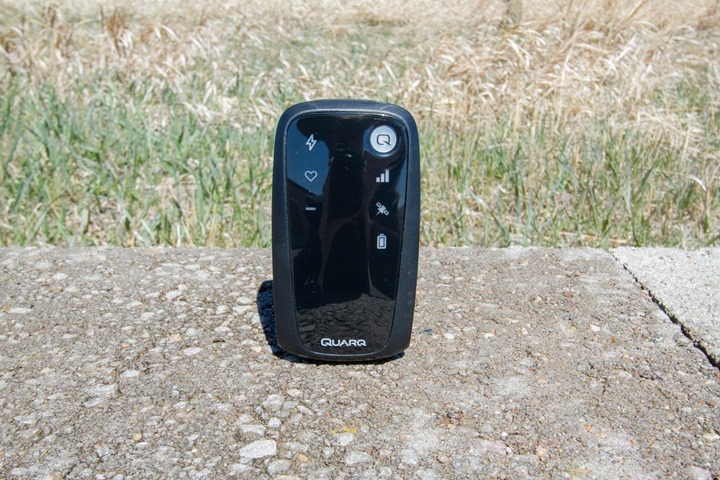

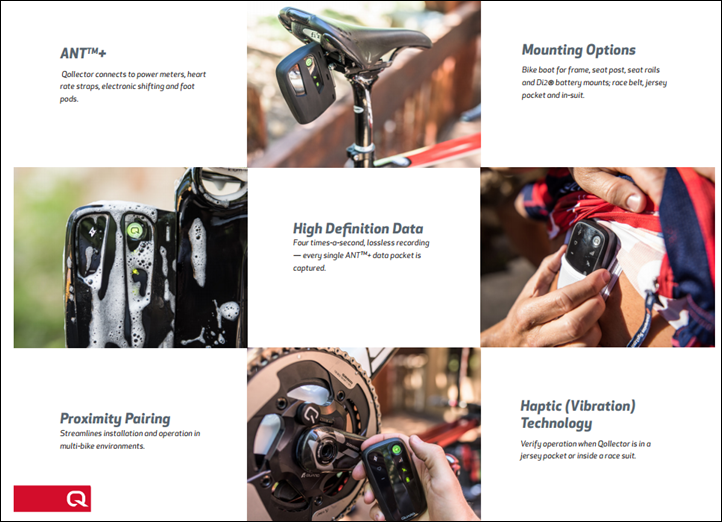
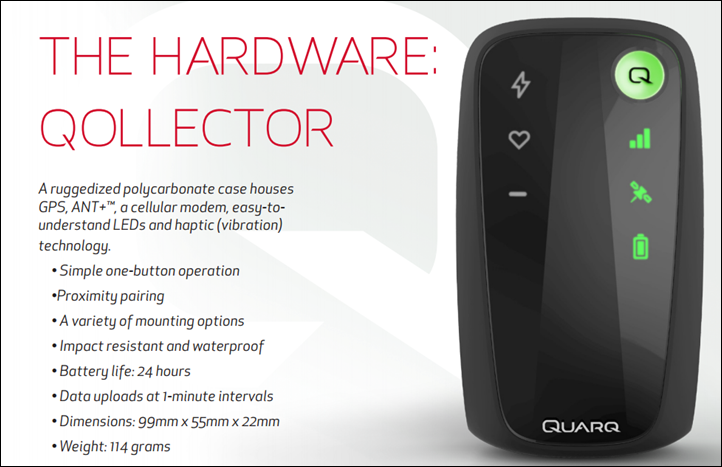

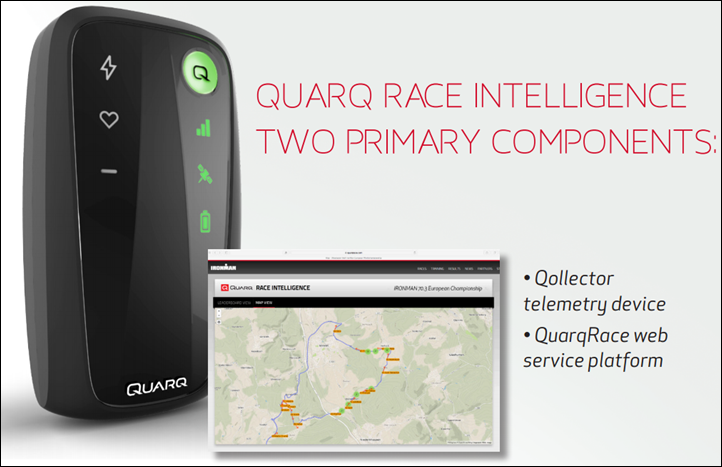

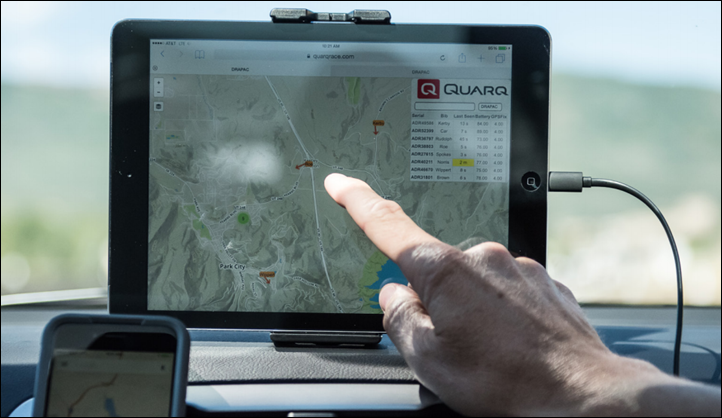
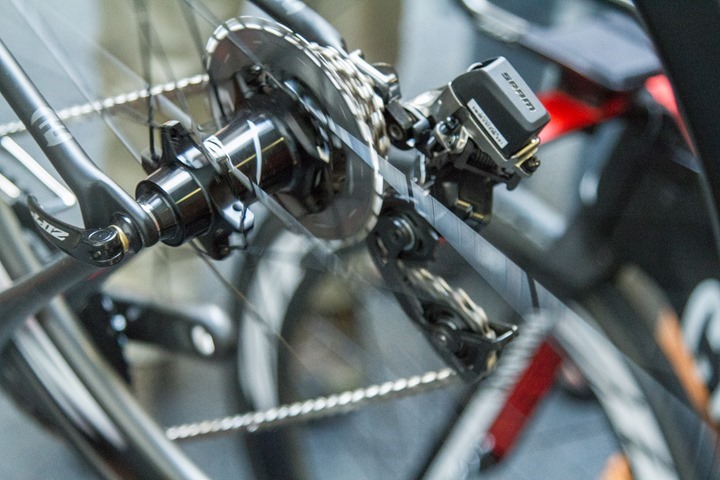
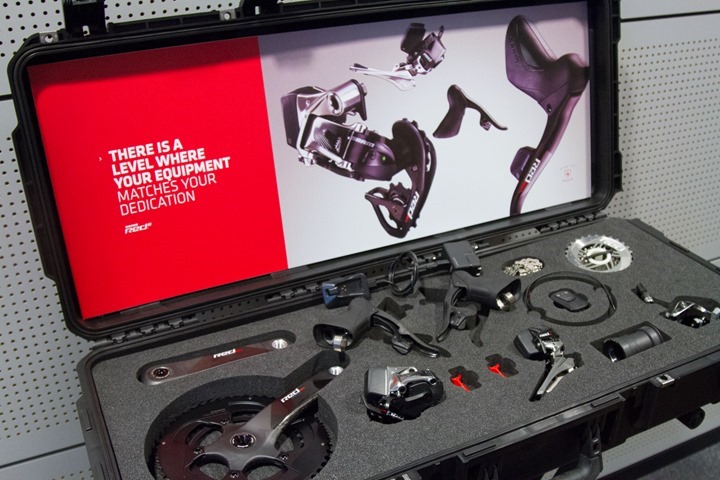
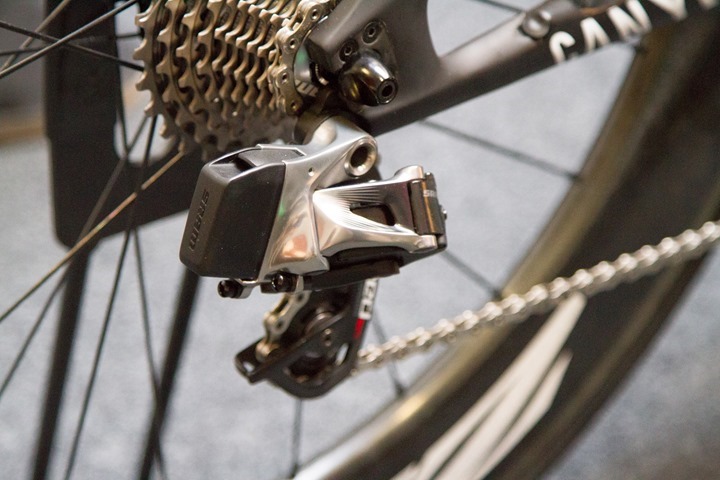
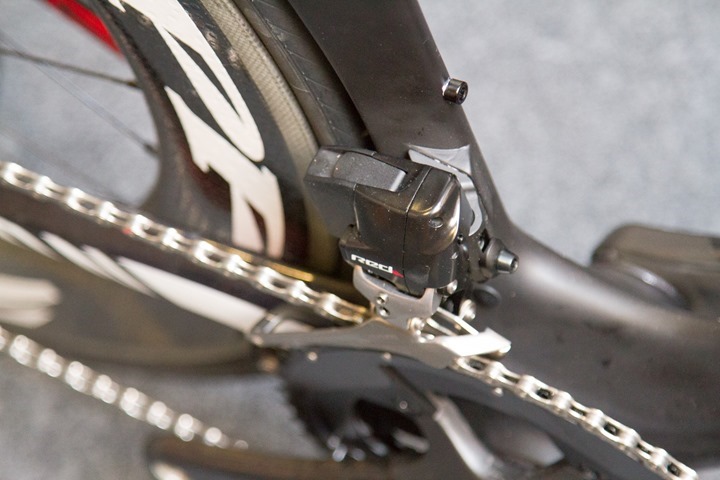





















Find it hard to believe that it took this long for something like the Quarq race intelligence (Dimension Data) to come to the pro peleton this year and didn’t even have ANT+.
F1 has had this for how many years now?
Actually it was in the TdF years ago, then UCI banned it. The unbanning is what triggered us seeing it again.
Besides the “gee whiz” factor, I’m not sure whether there is a reason to be an early adopter on this over less expensive wired system on a pre-built bike. But it sure makes retrofitting a non-electronic shit bike easy.
SHIFT
I can see it taking quite a bit of weight off a bike with internal cabling, actually. I’m interested in it for this reason above all others, actually, and for a tri/TT bike it might even price out lower than Di2, without the silly power box to stash around. It’s pretty intriguing stuff, for sure
That is a fantastic typo :)
Who wants a crappy non-electronic bike in this day and age!
Wow Quarq also have new thing to impact to current powermeter marketing
Will F1 get down Di2 on the ground?
Great details Ray. I’d have to say I don’t see the point for wireless shifting. Yeah, it’ since not having to run wires but there is so much radio traffic there these days that means interference is bound to be an issue sooner or later. I’m assuming this runs in the 2.4GHz band or some other worldwide open frequency? Hey, there’s not much radio traffic there … The security will stop someone hijacking it but it won’t stop someone jamming it either intentionally or accidentally. Then you’ve got no shifting and what were the benefits? It’s not like you move your derailleurs around, I guess a bit of flexibility in button placement is great but it’s not like you move them once you’ve sorted out where you want them to be.
Just run some wires and spend your money elsewhere in the system. It’s just not worth it! I’m sure this will work better then Mavic’s Zap system from many years ago. It shifted brilliantly, was great to have some extra shift buttons around the bars but boy did it suck getting stranded in a gear when out on rides. I know things have improved but it just doesn’t seem like job for wireless!
Do you mean a man in the middle attack (MITM) ? if it does AES encryption I am sure they have key exchange hopefully properly setup to ensure identity of the client/server
There is no display so key exchange is a bit limited (No chance for having a PIN like Bluetooth) so that’s the weak point. Now the chances someone will carry out that attack would seem small since its bike shifting but still easy to do in that if a bike in unattended you could walk up to it and pair the drivetrain without anyone knowing allowing you to listen in on the pairing as it happened.
For those interested:
link to courses.cs.washington.edu
No, that doesn’t work. As soon as you pair a device, it locks out a new pairing. So it’s sorta a short-lived attack.
The devices can only be paired once? That makes no sense. Break a derailleur and replace the shifter too because while the shifter works fine it can’t be used with a new device?
The attack doesn’t require any capability to pair to more then one device at a time.
No, it can only be paired to a single device at a time. So going and re-pairing someone elses’s bike has no real value. They’ll notice instantly upon first shift (likely within a minute). No different than going and just loosening shifter cable today wired. You have physical access to the bike, there’s little you can do.
But today, you’d have to mechanically deal with that. In this case, you just re-pair and in 15 seconds you’re good again. I don’t really see any issues aside from a practical joke with a friend.
I’m not saying its that practical to do, but at the pro level….
So you go up to a bike and start a pairing on the existing equipment. At the same time you packet sniff all the wireless data being communicated between the devices. That gives you the keys that will allow you to break the AES encryption done between devices and let you insert your own packets and listen in.
Not to mention simply jamming the spectrum these devices operate on. No need to hack it when the signal simply is not getting to the derailleur. The best time to do this is right when someone is about to go on the attack.
We are used to wires, but just as wifi has completely dominated wired Ethernet (and may itself succumb to LTE), I think that wired options will very soon become the expensive option. Heck, you need to build your frame around them and then thread them – that’s a lot of work, we’re just used to it so it seems normal and sensible like a land line did 30 years ago.
Re: jamming the signal frequency: that would be my main concern. I’m pretty sure I could rig something up that emitted noise at a particular frequency. And I’m not trained in electrical engineer. Then just stand at the bottom of a climb and cause chaos and watch everyone trying to ascend in the big ring. Encryption would be of no help.
I hope they’ve included an alogorithm for automatically changing frequencies if there is noise. I am pretty sure I could rig something up that emitted at several frequencies, but it would take some thought and would deter a lot of nutters.
Good point, but I don’t think we’ll be using wireless brakes.
Saw a few other details in other reporting on this
– uses 128-bit rolling encryption, which at a minimum would make MITM attacks more difficult as the key would keep changing. Not impossible, but much more difficult.
– uses 2.4GHz spread spectrum, which I guess means use of multiple frequencies or is adaptive to find clear space. Broad jamming could probably still affect it, but at that point you’d need a powerful signal and to be quite close.
I like that they’re using a 1:1 pairing, this is a nice simple approach to avoid a number of issues.
The unlicensed part of 2.4GHz is still relatively small to make it easy to jam. Of course you’d also jam and Bluetooth, BLE, Wifi, or ant signal at the same time.
I don’t think comparing to the wireless trend in computers is valid. For a bike the derailer and shifter are always in the same location so a wire in one location will always connect them. Its not like computers have a dedicated location and the router a dedicated location so everyone would just have one wire to connect them. Even if you don’t factor in how laptops and then tablets became popular so they were always moving relative to the router it was hard to wire in a desktop as people didn’t buy a house with designated locations for things.
The whole protocol is closed and non-standard. There might not even be an off-the-shelf sniffer one could use, much less allow anybody to insert messages. They might not even use a constant frequency or encoding protocol. Good luck in hacking that.
Shouldn’t it be “Wired remote _shift_ buttons (called ‘Blips’)” – unless you know something we don’t :)
Thanks for writing “hackers” with double quotes ;)
“Shite” buttons, I LoL’d!
Funny that a bike shifter is more worried about security than car manufactures that have all the ports open….
So you can’t shift the front chainring and rear cog at the same?
Typo: Wired remote shite buttons
Ray,
Would this be compatible with older bikes? So where DI2 will not fit because the cabling is not available on my 2006 Trek Madone 5.5, would this be an option I wonder?
Also bit of a typo you may wish to correct, see attached………. ;-)
“That is a fully proprietary/closed…”
Will someone remind SRAM about Kerckhoffs’s principle.. amazing that we still haven’t progressed a single inch since 1883 when it was stated. Security by obscurity doesn’t work in the real world.. it’s like peeing in your pants when it’s cold.. yes, at first you feel warmer.. but in the end.. well, try it out yourself.. let’s say you are now no just cold ;-)
But now I’m cold and my office mates are complaining about the smell. I don’t like your experiment
I’m not sure why any company would be willing to publicly state they are associated with the mess that is the live ironman tracking web site…
Quarq is feeding data into it for the pro athlete side – not the amateur side.
I’m sure it’s not the data feed the issue… but the IM live results front end is, errr, let’s just say “unreliable” (both on the pro side and amateur side, although amateur side is basically just extrapolation from the timing pads).
To be more blunt, the IM website is a clusterf*** of bad designing and programming. Combined, intertwined. For example, IMMT was showing pro splits as 0:00:00 even though the race was finished for a while. You couldn’t find leaderboards unless you checked the Twitter feed. Etc., etc.
My point is, I’d keep my PR distance rather than be associated with that.
Yeah, I guess it’s a work in progress with Quarq taking on and owning the pieces they own (which seem to work well) – and IM doing whatever they do.
Fully agree with Guillaume. When I read about this, i was thinking that we better see changes in IM page this weekend for Zell am See…
Any word on about a wireless TT setup?
This will be a wonderful solution for electronic shifting on a tandem. Hopefully they’ll come out with a MTB specific RD in the future that I could use on my beloved tandem.
Um, longer wires don’t work? Or do you mean the way some tandems break apart so now you won’t have to deal with the wire?
Longer wires will work however it wouldn’t look very good. Internal wire routing on a tandem is very complex and expensive due to the inclusion of BB eccentrics that are not present on a single bike. Santana will build a custom frame for internal wiring for Di2 but the internal wiring itself is a $1000 option. If SRAM comes out with a triple FD and MTB specific RD I will go for the upgrade. Auto trimming on a triple FD will be a delight on the tandem.
pretty cool stuff – i’d like to hear a comparison between durace di2 and this system.
i do like how sram has changed shifting to be more ‘car-like’ – right shifter shifts up
left shifter – shifts down
to change crank rings – press both at the same time.
shimano take note!
I often shift chain ring and derailuer at the same time, so personally I hope Shimano keeps things the same.
I would welcome the ability to choose different shifting modes in the Di2. Shimano 4 button or SRAM 2 button style. I am also interested in seeing sequential shifting modes and the ability to restrict cross chaining.
Interesting, but it doesn’t quite cater for the way I shift. I often shift both the rear and front derailleur at the same time to keep my cadence steady.
So you make a 3 cog shift on the rear while at the same time changing the front chainring, that is a recipe for chain dropping. Now doing one then the other quickly yes and you could do that with this system.
Some observations:
It gets about 600 miles per charge on the derailleurs (shifters they claim a year of use between charges) vs Shimano Di2 of 1000-1500 miles (I get 1000 miles indoor use during winter, 1500 miles outdoor summer on Di2 internal battery)
They don’t say what frequency it uses (which will tell you what might interfere) but, they say it uses “powerful spread-spectrum radios” which implies it’s using more than one band at a time, so if one is interfered with, the other should still be able to carry the signal.
They say they’ve been working on it for 5 years! This is very shocking as they started that anti-electronic groupset *4 years ago
The front shifting under (light) load in the GCN video is perfect and appears to match my experience with Shimano Di2. (Although, I never do a complete cross-chain like he did for the test)
In 90% of situations, the shifting for the front should be no problem (use both shifters at same time, if it’s big, it goes small, if it’s small it goes big), but a few things make this not perfect. First, if you’re eating and steering with one hand, you can’t shift to the small ring (requires both hands). Second, sometimes on the road, I forget if I shifted to the big/small ring, so I press that shifter (don’t want to take eyes off road) and if it’s already there, it does nothing. With SRAM, any front-derailleur press will cause a shift, so you’d lose whatever gear you’re in. (However, they did put in ANT+, so if you have the latest Garmin Edge/firmware, you can show the gear on your Edge)
One of the worst kept SRAM secrets is that most (nearly all) of their upgrades are compatible with at least the most recent generation of their kit.
Since the cranks aren’t part of the group one could upgrade the derailliuers and shifters and start riding. Assuming of course that you already rode SRAM and had an 11 speed cassette (@28t or smaller).
The new market will be huge but I’m guessing more than a couple of us will go this route and breathe new life into our old, loved pre-DI2 frames.
Also the swap the front to the rear to get home design feature is cool. I’m with the revolutionary camp.
Finally regarding the jamming concerns stated here – you guys need to read about the Tour of California tests. If you believe any of that stuff.
Love what you ride
But if this device is designed for IM, why wasn’t it designed for the swim leg?
eTAP on Mirinda Carfrae’s Felt. She’ll ride the groupset in Kona.
50 hours?
uh, PBP is 1200 KM with a 90 hr time limit.
60 hours. In those cases you simply bring an extra battery pod, they snap right in and are fully swappable between the two. It’s smaller than a pack of gel.
I would love an eTap system for my 1×11 mountain bikes!!!
Ray, what I don’t understand is why SRAM “fresh approach” doesn’t include any coverage of sequential shifting?
What they’ve done (apart of what’s under bonnet) is to simulate traditional shifting using “front gears” and “rear gears”. With some side effect due to inability to shift both gears simultaneously and for some people it could be a sacrifice.
So why not to make a step further and reinvent sequential shifting, letting electronic brains to handle the difference in gear ratio when changing front chainrings? This way you can get true 22 gears and not 2 sets of separate (and sometimes overlapping) 11 gears.
^
|
|
This!
Will The Etap work with Campagnolo Cassette, I know it says up to 28 teeth, I have 29, will it work?